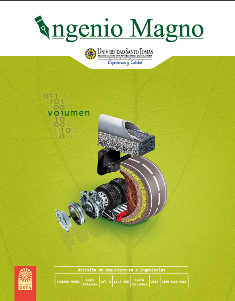Modelo de Bipedestación Erguida Normal y Patológica
Main Article Content
Abstract
Downloads
Article Details
DECLARATION OF ORGINIALITY OF SUBMITTED ARTICLE
With this document, I/We certify that the article submitted for possible publication in the institutional journal INGENIO MAGNO of the Research Center Alberto Magno CIIAM of the University Santo Tomás, Tunja campus, is entirely of my(our) own writing, and is a product of my(our) direct intellectual contribution to knowledge.
All data and references to completed publications are duly identified with their respective bibliographical entries and in the citations thus highlighted. If any adjustment or correction is needed, I(we) will contact the journal authorities in advance.
Due to that stated above, I(we) declare that the entirety of the submitted material is in accordance with applicable laws regarding intellectual and industrial property, and therefore, I(we) hold myself(ourselves) responsible for any complaint related to it.
If the submitted article is published, I(we) declare that I(we) fully relinquish publishing rights of the article to the University Santo Tomás, Tunja campus. As remuneration for this relinquishment of rights, I(we) declare my(our) agreement to receive two (2) copies of the edition of the journal in which my(our) article appears.
References
Smith J. The forces operating at the human ankle joint during standing. Journal of Anatomy, Issue 91, (1957), 545-564.
Miralles R. (Ed.). (1999). Biomecánica aplicada del aparato locomotor. Barcelona: Masson.
Winter D. Patla A. Prince F. Ishac M. Gielo-Perczak K. Stiffness control of balance in quiet standing. Journal of Neurophysiology. Volume 80, Issue 3, (1998), 1211-21.
Gage W. Winter D. Frank J. Adkin A. Kinematic and kinetic validity of the inverted pendulum model in quiet standing. Gait Posture, Volume 90, Issue 2, (2004), 124-32.
Loram I. Lakie M. Human balancing of an inverted pendulum: position control by small, ballistic-like, throw and catch movements. Journal of Physiology, Volume 1, Issue 540 (2002), 1111–1124.
Panzer V. Bandinelli S. Hallett M. Biomechanical assessment of quiet standing and changes associated with aging. Archives of Physical Medicine and Rehabilitation, Volume 76, Issue 2, (1995), 151-157.
Mora J. (Ed). (1986). Mecánica Muscular y Articular. Educación Física (Ciclo Superior). Cádiz: Diputación Provincial de Cádiz. Servicio de Deportes.
Jacono M. Casadio M. Morasso P. Sanguineti V. The Sway-Density Curve and the Underlying Postural Stabilization Process. Motor Control, Volume 8, (2004), 292-311.
Casadio M. Morasso P. Sanguineti V. Direct measurement of ankle stiffness during quiet standing: implications for control modelling and clinical application. Gait & Posture, Volume 21, (2005), 410–424.
Aftab Z. Robert T. Wieber P. Predicting multiple step placements for human balance recovery tasks. Journal of Biomechanics, Volume 45, (2012), 2804–2809.
Ramos, M. J. Rehabilitación del amputado. Recuperado el 4 de octubre de 2013, de http://www.sld.cu/galerias/pdf/sitios/rehabilitacion/rehabilitacion_del_amputado.pdf.
Ocampo M. Henao L. Vásquez L. (Ed). (2010).Amputación de miembro inferior: cambios funcionales, inmovilización y actividad física. Documento de Investigación, Facultad de Rehabilitación y Desarrollo Humano. Colombia: Universidad del Rosario.
Winter D. (Ed). (2009). Biomechanics and Motor Control of Human Movement. Canada: Wiley.

